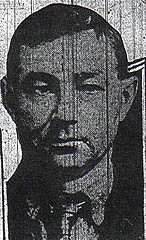Herman Lamm
| Herman Karl Lamm | |
|---|---|
 |
|
| Born | April 19, 1890 Kassel, German Empire |
| Died | December 16, 1930 (aged 40) Sidell, Illinois, United States |
| Cause of death | Suicide when surrounded by posse |
| Other names | "Baron" Lamm; Harry K. Lamb; Robert J. Masden; Thomas Bell |
| Occupation | Former member of the Prussian Army |
| Criminal charge | charge of Robbery 1914; suspicion of hold up 1918; arrested for burglary 1920; arrested 1927; arrested 1929 |
| Criminal penalty | Imprisonment in 1917 |
| Conviction(s) | Grand Larceny |
Herman Karl Lamm (April 19, 1890 – December 16, 1930), known as Baron Lamm, was a German bank robber. His robberies paid close attention to detail of the target properties, and he has been described as "the father of modern bank robbery". A former Prussian Army soldier who immigrated to the United States, Lamm believed a heist required all the planning of a military operation. He pioneered the concepts of meticulously "casing" a bank and developing escape routes before conducting the robbery. Using a meticulous planning system called "The Lamm Technique", he conducted dozens of successful bank robberies from the end of World War I.
In 1930 after a botched heist Lamm committed suicide when surrounded by a law-enforcement party in Sidell, Illinois. Lamm's techniques were studied and imitated by other bank robbers across the country, including the infamous John Dillinger.
Lamm was a member of the Prussian Army, but was forced out of his regiment after he was caught cheating at cards. After he was discredited, Lamm emigrated to the United States shortly before the outbreak of World War I in 1914. Lamm became a holdup man, and quickly started adapting his military training, his study of tactics, and his precision and discipline into the art of crime. He theorized that a heist required all the planning of a military operation, which included the development of contingency options in the event of unforeseen problems. Bank robberies in the United States were largely improvised at the time, resulting in varied degrees of success and failure among heists. Lamm sought to take the guesswork out of bank robbing. Lamm was arrested in 1917 after a botched holdup and served a brief stint in a Utah prison, where he developed what became known as "The Lamm Technique", in which he pioneered the concept of "casing" banks.
The system involved carefully studying a target bank for many hours before the robbery, developing a detailed floor plan, noting the location of safes, taking meticulous notes and establishing escape routes. He would occasionally have a man pose as a journalist to better understand the inner workings of the bank. Lamm assigned each gang member a specific job, along with a specific zone of the bank they were charged with surveying and a strict timetable to complete their stage of the robbery. Among the jobs he assigned to his fellow robbers were the lookout, the getaway driver, the lobby man and the vault man. He also put his men through a series of rehearsals, some of which involved using a full-scale mock-up of the interior of the bank. Lamm stressed the importance of timing during these practice runs, and used stopwatches to ensure the proper results were achieved. He only allowed his gang members to stay in a bank for a specific period of time, regardless of how much money they could steal.
...
Wikipedia
